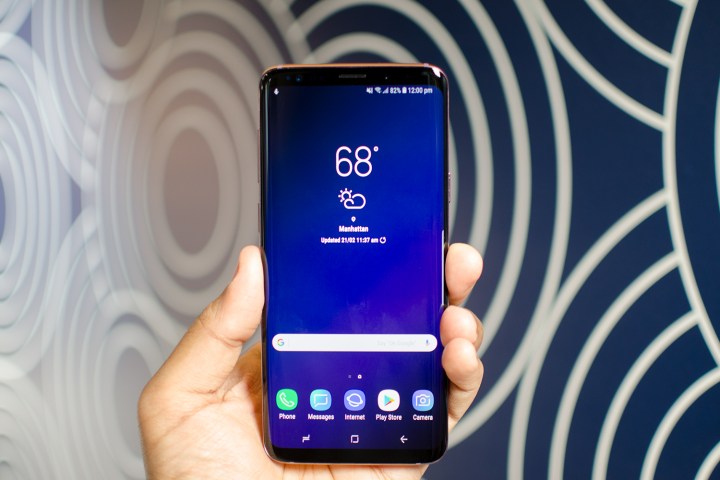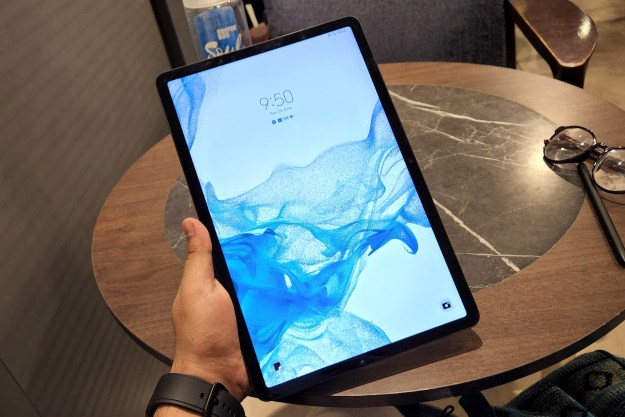Samsung’s latest flagship sailed onto the scene at MWC in Barcelona boasting an impressive new camera, a refined curved body, and a few other improvements over last year’s Galaxy S8. It’s an attractive smartphone that’s sure to tempt many, but in order to claim the title, it will have to knock out Apple’s reigning champion — the iPhone X. We decided to compare the two in various categories to see which comes out on top.
Specs and performance
| Galaxy S9 | iPhone X | |
| Size | 147.7 x 68.7 x 8.5 mm (5.81 x 2.7 x 0.33 inches) | 143.6 x 70.9 x 7.7 mm (5.65 x 2.79 x 0.30 inches) |
| Weight | 163 grams (5.74 ounces) | 174 grams (6.14 ounces) |
| Screen | 5.8-inch Super AMOLED | 5.8-inch Super Retina AMOLED display |
| Resolution | 2,960 x 1,440 (529 ppi) | 2,436 x 1,125 pixels (458 ppi) |
| OS | Android 8.0 Oreo | iOS 11 |
| Storage | 64GB | 64GB, 256GB |
| MicroSD card slot | Yes | No |
| NFC support | Yes | Yes (Apple Pay only) |
| Processor | Snapdragon 845 with Adreno 630 | A11 Bionic with 64-bit architecture, M11 motion co-processor |
| RAM | 4GB | 3GB |
| Connectivity | 4G LTE, GSM, CDMA, HSPA+, 802.11a/b/g/n/ac Wi-Fi | 4G LTE, GSM, CDMA, HSPA+, 802.11a/b/g/n/ac Wi-Fi |
| Camera | Super Speed Dual Pixel 12-megapixel rear, 8-megapixel front | Dual 12 MP rear, 7MP FaceTime HD front |
| Video | Up to 4K at 60 fps, 1080p at 240 fps, 720p at 960 fps | Up to 4K at 60 fps, 1080p at 240 fps |
| Bluetooth | Yes, version 5.0 | Yes, version 5.0 |
| Biometric authentication | Iris, fingerprint, face unlock, Intelligent Scan | Face ID |
| Other sensors | Accelerometer, barometer, gyro, geomagnetic, proximity, iris | Accelerometer, gyro, proximity, compass, barometer |
| Water resistant | Yes, IP68 rated | Yes, IP67 rated |
| Battery | 3,000mAh Fast charging (Quick Charge 2.0), wireless charging (Qi and PMA) | 2,716mAh 21 hours of talk time, 13 hours of internet, 14 hours of video playback, and up to 60 hours of audio playback Fast charging – 50 percent charge in 30 minutes, wireless charging (Qi standard) |
| Ports | USB-C, headphone jack | Lightning |
| Marketplace | Google Play Store | Apple App Store |
| Colors | Lilac Purple, Midnight Black, Coral Blue | Space Gray, Silver |
| Availability | March 16 | AT&T, Verizon, T-Mobile, Apple |
| Price | $720 | $999 |
| DT review | 4 out of 5 stars | 4.5 out of 5 stars |
The
The
Winner:
Design and display

The design of the Galaxy S9 is a slight refinement on the
Apple’s
Side by side, you will be hard pressed to pick the better display. The designs are so different that it really comes down to personal preference, though the lack of a fingerprint sensor on the
Winner: Galaxy S9
Camera
The headline feature for the Galaxy S9 is the camera. Samsung has packed in what it’s calling a Super Speed Dual Pixel camera, which is rated at 12-megapixels. It’s capable of switching between an f/1.5 aperture and an f/2.4 aperture, which means it can adjust for low light situations to take in more light with a larger aperture. It also takes shots with 30 percent less noise than the S8, by employing a multi-frame system that snaps 12 shots and combines them for best results. As for the front-facing camera, it’s rated at 8-megapixels and sports a fairly large f/1.7 aperture. Samsung’s Galaxy S9 Plus actually has a better, dual camera setup which allows for telephoto zoom and a more pronounced bokeh effect.
Apple also put a lot of effort into the
Winner:
Battery life and charging
You’ll find a 3,000mAh battery in the Galaxy S9, which should see you through an average day with change. That’s the same size battery that’s in the
Both phones support wireless charging, which is handy. They also both support fast charging, though Samsung has chosen to limit the S9 to Qualcomm’s Quick Charge 2.0, even though the Snapdragon 845 would in theory allow for QC 4. Although the
Winner: Tie
Software
The Galaxy S9 comes running
Samsung has surprised no one by throwing AR Emoji onto the S9, allowing you to create an emoji that reflects your facial expressions, just like Apple’s Animoji. The big software extra for Samsung’s S9 is Bixby, which has a range of AI tricks up its sleeve, enabling you to identify objects around you and translate in real-time. A lot of the same things can be done with Google Assistant and other Google apps, so we’re not entirely convinced that Bixby is essential.
The
Winner: Tie
Pricing and availability
Both phones are available from all the major carriers in the U.S. and you can buy them unlocked direct from the manufacturers, or on Amazon, Best Buy, Walmart, and a few others retailers. The
Overall winner: Apple iPhone X
This is a really tough contest to pick a winner for — yes, the Galaxy S9 is cheaper, but it all still comes down to how the camera and battery perform. We love the display and the design of the Galaxy S9 and Samsung has eliminated the biggest gripe we had with the S8 design by moving the fingerprint sensor. The S9 is a beautiful device and it feels great in the hand.
There’s no doubt that the
Editors' Recommendations
- iPhone 16: news, rumored price, release date, and more
- Best Samsung Galaxy S24 Ultra deals: Get Samsung’s flagship for $300
- A big iPhone update is right around the corner
- Best iPhone 15 deals: How to get Apple’s latest iPhone for free
- Are you having iPhone alarm problems? A fix is coming soon




